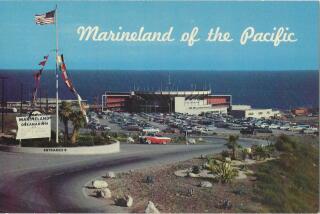A History of Steinbeck’s Cannery Row by Tom Mangelsdorf (Western Tanager: $29.95; 216 pp., illustrated)
- Share via
There are two good stories in this book struggling to emerge, but neither is given a definite shape or a pulsating life of its own. Together they fit much like a smelly sardine cannery would among today’s plush tourist entrapments on the Monterey Peninsula. And that is too bad because the story of the boom and bust sardine fishery, which rose and fell like redwood trees and gold mining in this state, has never been told.
As an infrequent visitor to the Monterey Peninsula since 1960, I have always wondered about those hulking remnants along Ocean View Avenue. They turn out to be another ephemeral landmark to the California dream of quick riches.
The friendship between author John Steinbeck and Edward Ricketts, the “Doc” of “Cannery Row” was a warm, supportive affair between two talented men who had problems with the women in their lives. Not much has changed between men and women in 50 years; and an evocative, penetrating telling of their story would make that simple fact clear.
The two stories were combined and eventually published because they would appeal to the hordes of tourists now pouring into town to view the Monterey Bay Aquarium. Cannery Row has been so sanitized and Steinbeckized that the author, were he alive, would probably be embarrassed to revisit what he immortalized as “a poem, a stink, a grating noise, a quality of light, a tone, a habit, a nostalgia, a dream.”
People search for parking spaces on or near Cannery Row now not to work but to play in what was once a very noisy, smelly, toilsome place. This book, while it does not evoke or adequately explain that place, does relate the basic facts as would a string of newspaper clippings. The facts speak of one more rip-and-run raid on the natural resources of the Golden State.
Beginning at the start of this century when the Italian sardine fishermen replaced the Chinese squid fishermen (and were replaced in turn by multinational tourists) and continuing to the end of World War II when the silvery fish disappeared from the shores of the West Coast, the canneries rose and fell with the vicissitudes of the market, availability of the fish, and frequent fires.
Interestingly enough, much more money was made by grinding the fish into fertilizer than in providing food directly to humans. The odor from the onshore reduction plants, which was partially offset by offshore plants operated to circumvent state laws, wafted across town and into the genteel noses of guests at the elegant Hotel Del Monte and purchasers of high-priced real estate on the peninsula. Lawsuits followed.
The cannery story is a typical California story, a fact that is never made clear in this book. There were muted warnings, attempts at passage and enforcement of toothless laws, lawsuits, and the final crash of the industry after one last mad fling during the war. One more resource was overused. Then silence and rot followed the demise of the clanking machinery until the tourists began arriving with copies of The Book in hand.
Ricketts was a marine biologist who interested himself in the sardine problem near the end of his life, and Steinbeck intermittently visited Cannery Row and lived and worked nearby. But their separate lives and joint friendship do not lend themselves to being mixed in with the fish. One was background to the other. This could be said of the two stories, and the two men.
Steinbeck, Nobel Prize and all, would be the logical choice as being the foremost character in the story of friendship. However, Ricketts emerges as more tragically flawed and thus more interesting, while Steinbeck resembles a caricature of a cafe society type at the time.
We never get a clear picture of that friendship or the sardine industry from this book, whose cover is hand tinted and whose text is flawed by typographical errors, such as Bug Sur for Big Sur.
More to Read
Sign up for our Book Club newsletter
Get the latest news, events and more from the Los Angeles Times Book Club, and help us get L.A. reading and talking.
You may occasionally receive promotional content from the Los Angeles Times.









